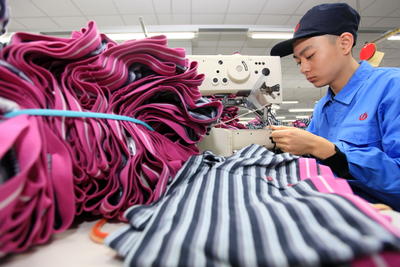Yet some commentators have recently suggested that rising input costs and RMB appreciation mean that China can no longer depend on exports as a driver of economic growth. Rising labour costs are already challenging China’s comparative advantage in low-skilled manufacturing. The large-scale migration of surplus rural labour to the urban manufacturing sector has given Chinese manufacturers access to a deep pool of low-cost labour. But this low-cost wage advantage is gradually dissipating, as the rural labour surplus shrinks and the Chinese government continues to grant minimum wage increases. Recent studies indicate that nominal wages growth — which has occurred by an average annual rate of almost 15 per cent since China’s accession to the WTO in 2001 — has not been sufficiently offset by productivity gains. One study found that between 2003 and 2008–09, Chinese unit labour costs, which adjust labour costs for changes in labour productivity, rose by between 1.8 and 7.4 per cent on average each year in RMB terms. Unit labour costs rose even faster in US dollar terms by an annual average of 5 to 10.9 per cent, reflecting the appreciation of the RMB.
Going forward, the Chinese government’s greater policy emphasis on market-based pricing and scaling back of subsidies in areas such as land, water, energy, fuel and capital will also affect the cost-competitiveness of Chinese firms reliant on subsidised inputs to production.
Finally, the RMB’s gradual appreciation will compound all of these cost pressures — China’s major exchange rate reforms in mid-2005 have since seen its real effective exchange rate rise by 30 per cent, a substantially greater appreciation than in many of its principal trade competitors in Asia.
As these trends continue — and as other low-cost emerging markets continue to make productivity enhancing investments in their own export sectors — China will become less competitive in low-cost, labour-intensive manufactured exports. But this decline is likely to be gradual, at least in the short term. China continues to enjoy unparalleled economies of scale in production, its logistics performance remains superior to all comparable emerging economies, and cost savings may still be found in China’s less developed western regions. Over time, higher labour costs in existing export industries will be somewhat counter-balanced by falling production costs in new, more advanced industries that will benefit from the latest round of new technologies and capital investment.
Meanwhile, China’s economy is undergoing two other structural transitions in its export sector. The first is China’s shift higher up the production value chain and toward greater value-adding activities. The combined value of heavy manufacturing and electronics exports has increased ten-fold in the past decade, and overall, the domestic value-added share of Chinese exports increased from 54 per cent in 1997 to 61 per cent in 2007, reflecting upgrades to China’s industrial structure.
Moreover, the ratio of exports to imports in processing trade — a measure of the contribution of domestic value-adding activities to processing exports — has since risen from 1.7 to 1.8, suggesting that the share of the final value of China’s processing exports generated domestically has increased further since 2007.
China is also making a necessary shift toward expanding exports to emerging markets following advanced economies’ subdued growth outlook, and signs of market saturation among some product groups within those economies. Emerging economies accounted for almost half of China’s export growth in 2012, due to their growing demand for intermediate and capital goods, such as construction machinery and equipment, which they require for their own industrial-led development. From 2000–11, exports of heavy manufacturing goods to emerging economies grew from 4 per cent of total Chinese merchandise exports to 11 per cent, while exports of electronics rose from 3 to 7 per cent. Exports to emerging economies will likely continue to rise as China’s export structure becomes increasingly geared toward the production of these more complex goods.
Ultimately, the relative decline in exports as a driver of GDP growth, and the shifting structure of Chinese exports, are inevitable steps in China’s economic development, similar to the experiences of former export oriented emerging economies. China’s export sector will remain instrumental in its eventual economic convergence with more advanced Asian countries. But the days of substantial trade surpluses and stellar growth in exports have probably passed. China’s challenge will be to support these structural transitions while avoiding sudden slowdowns and possible crises.
Policy settings will play a crucial role. China’s rapid industrialisation, and government policies designed to foster this process, have led to internal imbalances and deepening domestic structural risks. In addressing these imbalances, Chinese authorities will need to continue to remove factor price distortions, undertake financial and credit market reforms, support a more liberalised exchange rate regime and ensure continued innovation and improvements in workforce skills. This policy mix will support increases in the wage and consumption shares of GDP, and a reduced reliance on external demand, moving the economy onto a more balanced and sustainable growth path with an ongoing rise in living standards.
Brendan Coates, Dougal Horton and Lachlan McNamee are, or were, from the International Economy Division of the Australian Treasury. The views in this article are those of the authors and not necessarily those of the Australian Treasury
This article is an abridged version of a paper that was first published here in the Australian Treasury’s Economic Roundup in December 2012.
Normal
0
false
false
false
EN-AU
ZH-CN
X-NONE
/* Style Definitions */
table.MsoNormalTable
{mso-style-name:’Table Normal’;
mso-tstyle-rowband-size:0;
mso-tstyle-colband-size:0;
mso-style-noshow:yes;
mso-style-priority:99;
mso-style-parent:”;
mso-padding-alt:0cm 5.4pt 0cm 5.4pt;
mso-para-margin-top:0cm;
mso-para-margin-right:0cm;
mso-para-margin-bottom:10.0pt;
mso-para-margin-left:0cm;
line-height:115per cent;
mso-pagination:widow-orphan;
font-size:11.0pt;
font-family:’Calibri’,’sans-serif’;
mso-ascii-font-family:Calibri;
mso-ascii-theme-font:minor-latin;
mso-hansi-font-family:Calibri;
mso-hansi-theme-font:minor-latin;
mso-bidi-font-family:’Times New Roman’;
mso-bidi-theme-font:minor-bidi;}

